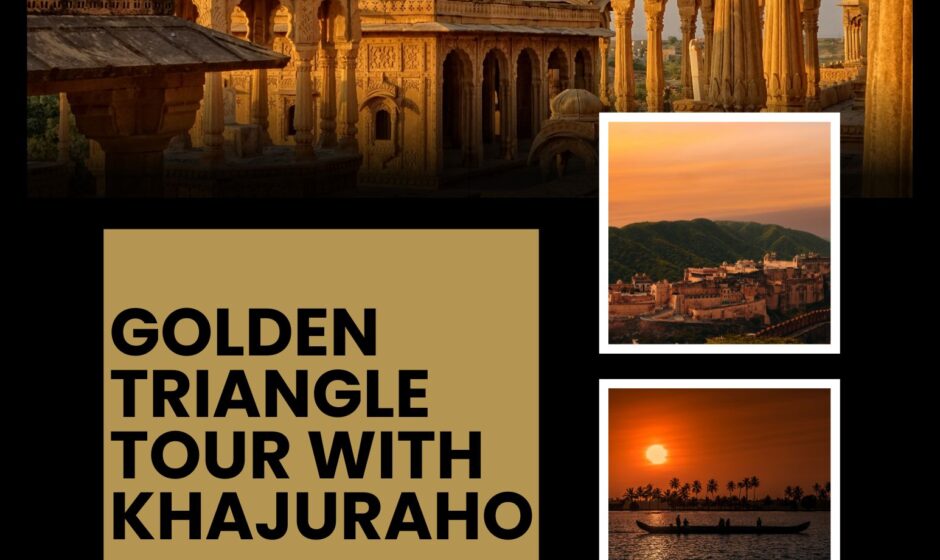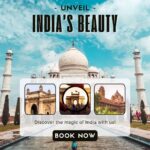India’s cultural diversity, ancient architecture, and deep-rooted traditions make it a dream destination for travelers. Among its many travel circuits, the Golden Triangle Tour with Khajuraho stands out as a journey that blends history, heritage, and artistic excellence. This route connects Delhi, Agra, and Jaipur—the classic Golden Triangle—with the UNESCO-listed temples of Khajuraho, known for their intricate carvings and sensual sculptures. This combination offers a deeper insight into India’s royal past and spiritual heritage.
In this complete guide, we’ll explore everything about planning a perfect Golden Triangle Tour with Khajuraho, including the best places to visit, ideal time to travel, itinerary ideas, and travel tips to make your trip unforgettable.
What is the Golden Triangle Tour with Khajuraho?
The Golden Triangle Tour includes three major cities in North India:
-
Delhi – The capital city known for its mix of Mughal architecture and modern charm.
-
Agra – Home of the iconic Taj Mahal and legacy of the Mughal empire.
-
Jaipur – The Pink City famous for its palaces, forts, and royal history.
When you extend this triangle to include Khajuraho, you add a spiritual and artistic dimension to your trip. Located in Madhya Pradesh, Khajuraho is renowned for its group of Hindu and Jain temples, which feature some of the finest examples of medieval Indian art.
This extended route lets travelers experience the grandeur of empires, the colors of Rajasthan, and the timeless beauty of temple art—all in one journey.
Why Choose Golden Triangle Tour with Khajuraho?
Here are a few compelling reasons:
-
Diverse Architecture: Mughal forts, Rajput palaces, and temple art come together in one itinerary.
-
UNESCO World Heritage Sites: Taj Mahal, Qutub Minar, and Khajuraho Temples are all on the list.
-
Rich Cultural Experiences: From Old Delhi’s bustling bazaars to Jaipur’s royal culture and Khajuraho’s spiritual depth.
-
Easy Connectivity: All destinations are well-connected by road, rail, and air, making it convenient to travel.
Suggested Itinerary: Golden Triangle Tour with Khajuraho (8 Days)
Here’s a popular and well-paced itinerary to follow:
Day 1: Arrival in Delhi
Arrive in the capital city and spend the day exploring:
-
Red Fort
-
Jama Masjid
-
Raj Ghat
-
India Gate
-
Qutub Minar
-
Lotus Temple
Evening at leisure or visit a local market like Chandni Chowk.
Day 2: Delhi to Agra (220 km, 4 hours)
Travel to Agra by road or train. Visit:
-
Taj Mahal
-
Agra Fort
-
Mehtab Bagh (for a rear view of the Taj)
Optional: Visit Itimad-ud-Daulah (Baby Taj).
Day 3: Agra to Jaipur via Fatehpur Sikri (240 km, 5 hours)
En route to Jaipur, stop at the abandoned Mughal city Fatehpur Sikri, a UNESCO site.
In Jaipur, check-in and relax.
Day 4: Jaipur Sightseeing
Explore the Pink City:
-
Amber Fort
-
City Palace
-
Hawa Mahal
-
Jantar Mantar
-
Jal Mahal
Evening: Enjoy a Rajasthani cultural show or dine at Chokhi Dhani.
Day 5: Jaipur to Khajuraho (By Flight or Train via Jhansi)
Take a morning train or flight to Khajuraho (via Jhansi if by train).
Evening at leisure in Khajuraho.
Day 6: Khajuraho Temples Tour
Discover the temple groups:
-
Western Group – Lakshmana Temple, Kandariya Mahadev Temple, and Vishwanath Temple.
-
Eastern Group – Parsvanath and Adinath Jain Temples.
-
Southern Group – Duladeo and Chaturbhuj Temples.
Evening: Attend the Khajuraho Light & Sound Show.
Day 7: Khajuraho to Delhi (Flight/Train)
Return to Delhi by flight or train. Use the evening for shopping or a farewell dinner.
Day 8: Departure from Delhi
Depending on your flight, explore any missed attractions or depart for your onward journey.
Highlights of the Tour
1. Delhi – The Capital’s Contrasts
Delhi offers an engaging mix of old and new. While Old Delhi showcases narrow lanes, spice markets, and Mughal monuments, New Delhi offers colonial-era buildings and upscale neighborhoods. It’s a great starting point to witness India’s transformation over centuries.
2. Agra – Romance and Majesty
No tour is complete without standing before the Taj Mahal. Its ivory-white marble, symmetrical beauty, and love story captivate millions. Agra also offers robust Mughal forts, gardens, and arts like marble inlay work and zardozi embroidery.
3. Jaipur – The Royal Legacy
Jaipur brings colors, culture, and royalty together. Amber Fort’s grandeur, the delicate architecture of Hawa Mahal, and the scientific precision of Jantar Mantar show how rich and advanced Rajputana was. Don’t forget to shop for textiles, jewelry, and handicrafts.
4. Khajuraho – Temples that Speak Through Stone
Khajuraho is like no other place in India. Its temples are not just places of worship—they are storytelling marvels. Built between 950 and 1050 AD by the Chandela dynasty, these temples showcase fine sculpture work that reflects daily life, mythology, and divine union. Contrary to popular belief, only a small percentage of the carvings are erotic—the rest depict musicians, dancers, warriors, and animals.
Best Time to Visit
The ideal time for a Golden Triangle Tour with Khajuraho is between October and March. The weather is pleasant, especially in Rajasthan and Madhya Pradesh, making sightseeing comfortable.
Avoid summer months (April to June) due to extreme heat, especially in Agra and Jaipur. Monsoons (July to September) bring lush landscapes but may disrupt travel plans.
Travel Tips
-
Start early on sightseeing days to avoid crowds and afternoon heat.
-
Book flights and trains in advance, especially for Khajuraho, as availability can be limited.
-
Dress modestly, especially when visiting temples and mosques.
-
Carry cash in small denominations for tips, local guides, and small purchases.
-
Hire local guides at Khajuraho and Fatehpur Sikri to understand the symbolism behind the carvings and architecture.
-
Stay hydrated and always carry sunscreen, sunglasses, and hats.
How to Reach Khajuraho
There are three main ways to reach Khajuraho:
-
By Air: Khajuraho Airport is well-connected with Delhi and Varanasi.
-
By Train: Jhansi is the nearest major railway station; from there, Khajuraho is about 5 hours by road.
-
By Road: Buses and private taxis are available from Jhansi, Satna, and other nearby towns.
Ideal Duration
To truly enjoy the Golden Triangle Tour with Khajuraho, plan for 7 to 10 days. It allows you to explore major attractions at a relaxed pace without feeling rushed.
Customizing Your Tour
Want to personalize your journey? Here are some ideas:
-
Add Varanasi after Khajuraho for a spiritual dip into the Ganges.
-
Explore Ranthambore National Park between Jaipur and Agra for a chance to see Bengal tigers.
-
Spend an extra day in Delhi to dive into museums, food walks, or neighborhood tours.
-
Opt for a luxury train tour like Palace on Wheels, which includes Khajuraho in some packages.
Conclusion
The Golden Triangle Tour with Khajuraho is more than a vacation—it’s an immersive experience through time, culture, and art. From Delhi’s monuments and Agra’s love stories to Jaipur’s regal charm and Khajuraho’s spiritual finesse, every destination adds a unique flavor.
Whether you’re a history buff, a culture lover, or a traveler seeking something extraordinary, this extended Golden Triangle trip will leave you with a deeper appreciation of India’s beauty and heritage.



